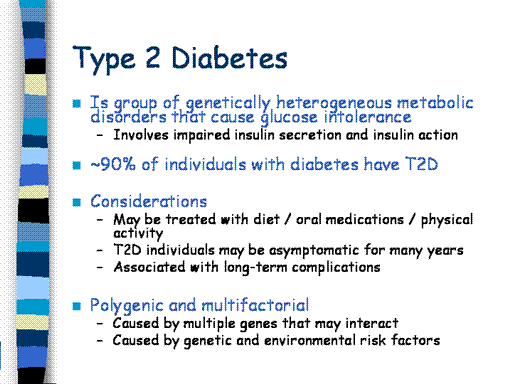| front |1 |2 |3 |4 |5 |6 |7 |8 |9 |10 |11 |12 |13 |14 |15 |16 |17 |18 |19 |20 |21 |22 |23 |24 |25 |26 |27 |28 |29 |30 |31 |32 |33 |34 |35 |36 |37 |38 |39 |40 |41 |42 |43 |44 |45 |46 |47 |48 |49 |50 |51 |52 |53 |54 |review |
 |
T2D is the
most common form of the disease, and is associated with a late age of
onset (generally after age 40 years). T2D can often be treated with
diet, physical activity and / or
oral hypoglycemic drugs. Insulin
therapy may be used to improve metabolic control, but it is not
necessary for survival. As a result, T2D may be relatively asymptomatic
for many years before diagnosis.
T2D is
considered to be a group of genetically heterogeneous metabolic diseases
that ultimately result in glucose intolerance.
Individuals with T2D generally have impaired insulin secretion
and / or impaired insulin action.
Both types of impairments ultimately lead to glucose intolerance and
increased levels of circulating fatty acids.
T2D is likely
caused by defects in multiple of genes, each of which appears to have a
small effect. However, the
interaction of these genes ultimately results in the onset of the
disease. Thus, T2D is considered to be a polygenic disease.
It is also considered to be multifactorial since environmental
risk factors, particularly obesity and lack of physical activity,
contribute to development of T2D.
|